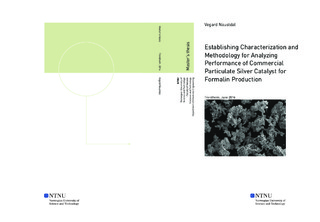| dc.description.abstract | Formaldehyde is the simplest aldehyde and is an active organic compound in many reactions making it a versatile building block for the chemical industry. Formaldehyde can be produced by partial oxidative dehydrogenation of methanol over a silver catalyst. The silver catalyzed process is the preferred technology in terms of operation cost and energy consumption, however the process has some challenges in product yield. This giving the silver processes the highest potential for increasing its yield and thus making the process more profitability.
This thesis have two focus areas. First to establishing a suitable characterization methodology for Ag based catalysts, this to identify factors critical to selectivity and stability of the process. Samples from fresh and plant exposed catalyst are investigated using techniques as scanning electron microscope (SEM), X-ray diffraction (XRD), X-Ray fluorescence (XRF), Thermo gravimetric analysis (TGA), Nitrogen adsorption and oxygen chemisorption.
And second, to establish methodology where one can study the silver catalyst in conditions of industrial interest. This by to converting an already existing DME rig to be suitable to run methanol to formaldehyde (MTF) synthesis and try to achieve conversions and selectivity close to what is achieved in the industry.
SEM reveals a massive change in the morphology in the plant exposed catalyst compared to the fresh catalyst. Pinholes in the plant exposed catalyst is observed. From the literature it is proposed that pinholes is due to formation of water in the bulk, indicating that there is bulk diffusion of both hydrogen and oxygen under industrial plant conditions. There are also seen structures similar to carbon structures.
The XRD analysis shows a growth in crystallite size for the plant exposed catalyst, which is expected from metal exposed to high temperatures. The quantitative calculations for XRF analysis gave 100 % silver for both the fresh and the plant exposed catalyst.
Temperature programmed analysis in TGA, did not show any apparent weight change. Oxygen is a low molecular weight specie compared to silver, as the oxide layer is at the surface raises the question if the weight change is detectable. To support this silver oxide was reduced in a TGA and no weight change was observed after the analysis.
The nitrogen adsorption did not yield any results for the surface area. This is believed to be due to low surface area of the silver catalyst and therefore not possible to measure it with nitrogen adsorption. However, by using a gas with lower vapor pressure like krypton it should be able to yield results for measuring surface area. The oxygen chemisorption did not give any reliable results.
Creating a rig suitable for MTF synthesis is not a trivial, an ideal setup is not necessary a practically one so compromises were made. Several aspect as calibration of MFC, LFC and CG, stabilized vaporization, avoiding condensation in pipelines, accurate temperature and control, and suppressing gas phase reactions have been taken into consideration.
The significance of temperature and flow is seen in both selectivity and conversion. The methanol conversion was highly dependent on oxygen concentration.
The reactor oven had a large temperature gradient and a large heated area, the reactor had a large heated void volume. This promotes gas phase reactions. By reducing the void space in the reactor with SiC the conversion and selectivities is approaching industrially performance. The conversion reached was 90 % with 84 % formaldehyde selectivity 7.5 % selectivity to CO and CO and 1 % selectivity towards CH4. This was achieved using a feed composition of 8 % methanol 11 % water 3 % oxygen and 78 % nitrogen with 250 NmL/min and 600 °C oven set point temperature. Both reactor design and oven design should be reconsidered combined with reducing the pipelines in the rig.
From the experiment testing for external mass transfer it is hard to determine if there are any external mass transfer limitations. The temperature effect on reaction rate is exponential resulting in deviation from isotherm conditions have effect on kinetic data. The decrease in reaction rate from 500 to 863 NmL/min might be due to the temperature decrease. The increase in reaction from 250 NmL/min to 500 NmL/min might indicate that there are mass transfer limitations in that area, or can be a concentration effect due to lower conversion at 500 NmL/min. | |

